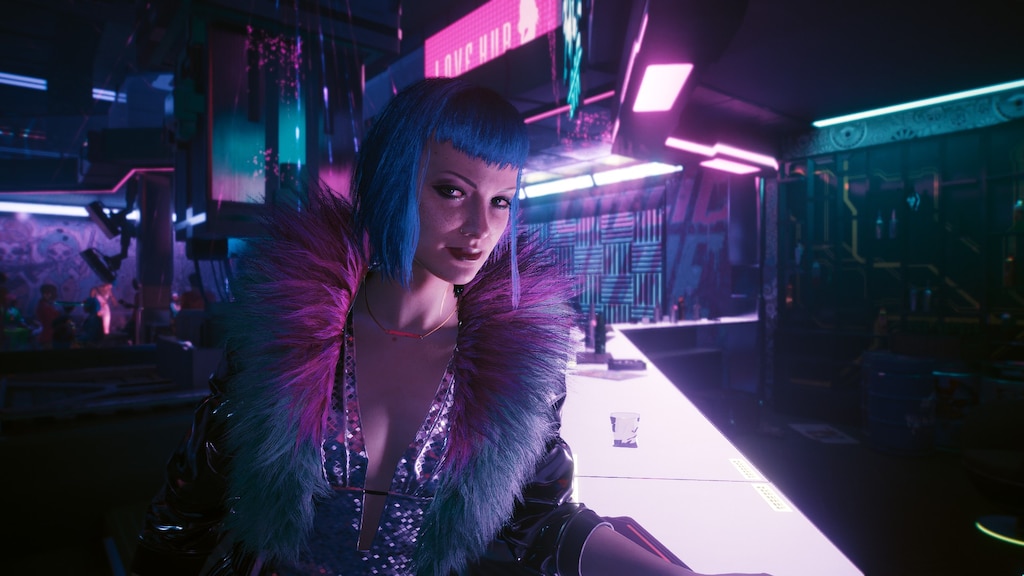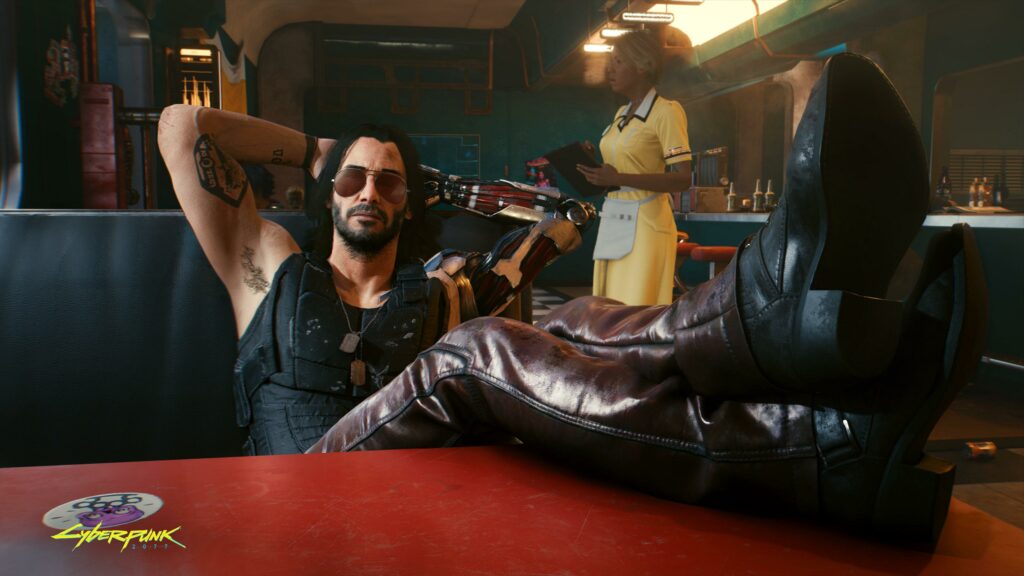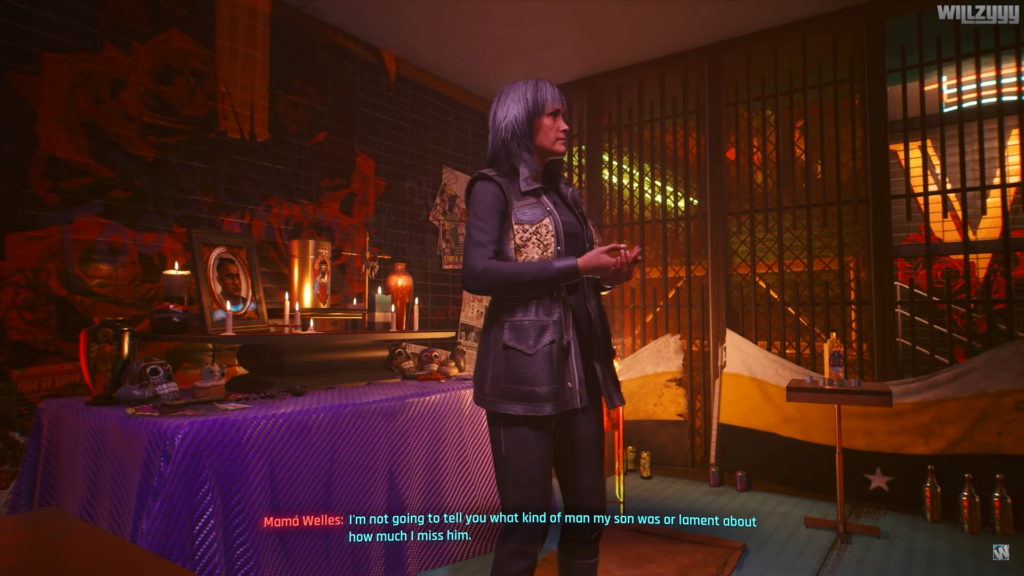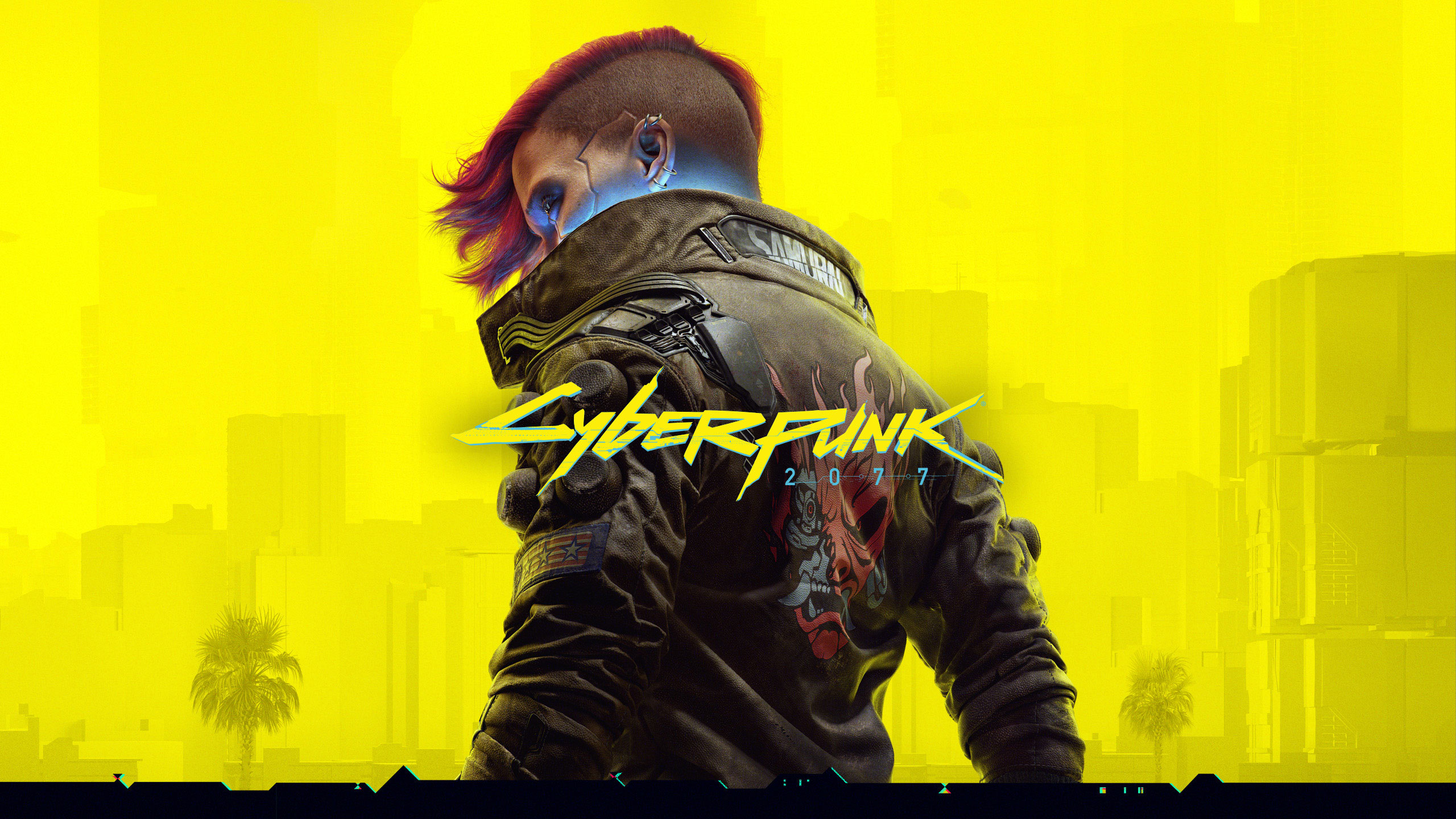This research paper was written for a game design class this semester, however, it was appropriate and fit the theme of my blog.
The Overwhelming Success of Cyberpunk 2077 Through the Lens of a Narrative Experience
THESIS / INTRODUCTION
Cyberpunk 2077 is a narrative-driven, open world action RPG set in a futuristic landscape which was developed by CD Projekt RED and released late 2020. The release of this game was surrounded by controversy due to countless bugs, performance issues and the unfortunate curse of ‘hype’ – many early players feeling the game was released in an unfinished state. As such, this game initial reception was poor; however, the game has since been improved continuously; and with the recent release of it’s expansion pack, Phantom Liberty, along with the 2.0 update the game finally is playable in what seems to be a complete state.
In this paper – despite all the controversy and backlash – I argue that even upon release Cyberpunk 2077 truly was, and is, a pinnacle of narrative driven video games.
As such, the scope of this paper will disregard much of the – well deserved – criticism surrounding gameplay and discuss the game through the lens of an immersive narrative experience. Please note as this paper discusses the narrative elements of Cyberpunk 2077, it will contain spoilers for the base game. Furthermore, for the remainder of this paper, we will simply refer to the game a “Cyberpunk”.
To provide context, Cyberpunk takes place in Night City, a futuristic city on the west coast of what was once the United Sates of America and built on the foundations of capitalism. In this game world, a small handful of megacorporations dominate the local infrastructure and wealth disparity is at an all time high. Those employed by megacorporations live comfortable – often lavishly – while the remainder of the population is subject to harsh living conditions, high rates of crime and affected by an abhorrent disregard for human life. In this world great advancements in medical research allows for the population to modify their bodies with pieces of robotics – cyberware – to enhance both their physical and cognitive abilities.

The game places the player in the shoes of V, a mercenary involved in the criminal underworld of Night City, who upon undertaking a job to steal a piece of experimental technology from the head of the most influential corporation in Night City finds themselves in a battle for their own humanity. This piece of technology is referred to as “the relic”, an data shard – a futuristic SD card – that contains the digital personality construct of an individual – specifically, a terrorist rocker-boy known as Johnny Silverhand. Upon a botched heist, V is forced to slot the chip into themselves, which in turn results in their personality merging with, and slowly being overwritten by Silverhand. The neurons in their brain being restructured into those of Silverhand.
Despite being an open world, first person shooter, action RPG, much of the game consists of dialogue and narrative interactions. We will further discuss how the game blends it’s narrative elements with gameplay; however, for this distinction, I argue that the sections of Cyberpunk falling under the standard definition of gameplay – shooting, driving, etc. – are overshadowed by the narrative portions. These narrative portions being its central focus.
In Marcello Arnaldo Picucci’s article “When Video Games Tell Stories: A Model of Video Game Narrative Architecture, Picucci (2014) describes three narrative structures in which video games can be classified under. Discovery narratives as detailed are narratives which “[rely] on players’ free exploration of the game world and subsequent discovery of story information” (Section 3.2 – Discover Narratives) and contain the “presence of side-stories and/or multiple story branches. While an overarching pre-established storyline is still present” (Section 3.2 – Discover Narratives). Cyberpunk perfectly fits this description as an open world game where players are guided along an overarching story, while being provided the option to partake in various side stories which provide deeper context to the characters and the world around them. Ultimately, there are key missions which must be completed, however, the choices made throughout the optional components impact and alter the overall narrative – and the ending. Using this structure, “the designers intentionally [withdrew] large amounts of story information from the main narration in order to weave them into the game world and among its inhabitants” (Picucci, 2014, Section 3.2 – Discover Narratives).
Considering this narrative structure, the main story arc in Cyberpunk is relatively short. According to www.howlongtobeat.com, the game can be completed within 25 hours should players choose to avoid any side stories; however, opting to complete the game and all its micro stories would take approximately 61 hours. Considering this is over double the runtime of the principal narrative arc, the opportunity for players to deeply immerse in the world and characters they encounter is bountiful; and in my opinion, highly suggested as this is where the game stands out amongst its contemporaries.
CHARACTERS
One area in which the game shines is in its characters, and its presentation of these characters. In his 2020 article titled “Narrative video game aesthetics and egocentric ethics”, Jens Kjeldgaard-Christiansen explores how video games allow for “player-focused (egocentric) moral experience that can be distinguished from the other-focused (allocentric) moral experience that characterizes literature and film” (Abstract Section, p. 88). In this article, Kjeldgaard-Christiansen praises the game Life Is Strange for populating its world with characters that are “ostensibly socially human”; stating “they are represented as having hopes, fears, beliefs, desires, regrets, heartbreaks, and other experiences and subjective states that we recognize in ourselves and in others” (2020, p. 94). The same can be said about the characters presented throughout the narrative in Cyberpunk, each of which are complex with their own motivations, histories, and personalities. As much of the game consists of dialogue and exposition, players are able to from deep connections with the characters they encounter. The game’s graphics and voice acting – supported by the writing – truly make the characters the player encounters feel human. This is shown in the attention to detail in their animations – specifically facial animations – which are afforded by the use of motion capture technology. While conversing with characters, their faces truly display the emotions that are being expressed through micro adjustments in their eyebrows and the corners of their mouths. There are times in the dialogue where rather than verbal acknowledgement, characters will respond through body language – and through this body language the characters successfully foster empathy in the player.

Furthermore, in Lee Sheldon’s 2022 book, “Character Development and Storytelling for Games”; Specifically, the chapter titled “Respecting Characters”, Sheldon states that well rounded characters are considered three dimensional (p.35). Further expanding on the idea, stating “the three dimensions of a character are physical, sociological, and psychological” (p. 35). In this sense, the physical dimension describes how a character looks and their physical features; arguing that “most often, [the features are designed] to reflect the character’s personality or function in the game” (p. 36). The sociological dimension “includes the character’s past, their upbringing, and their environment, both local and cultural” (p. 37). Lastly, the psychological dimension includes “the actions of the character, their attitudes, their opinions, [and] their view of the world” (p. 37). I would argue that all central characters in Cyberpunk fit Sheldon’s description of a three-dimensional character. Take into example Jonny Silverhand – who appears throughout the game not only as a voice in V’s head, but as a physical hallucination interacting with the world around the player. Physically, his character design supports the aesthetic of extremist the rocker boy sporting long hair, dog tags, patchwork tattoos and nothing but a bullet proof vest covering his toro. The character’s sociological and psychological dimensions are portrayed both through exposition and sections in which V is reliving Johnny’s memories. Through these, we learn Johnny was once a loyal solider who was employed by and supported the megacorporations, only desert due to his ever-growing hatred of authority. He routinely puts his cynicism on display describing his hatred for the current state of the world. We learn of his career as an anti-authoritarian and anti-capitalistic rock star – and with that, his narcissism. And most importantly we learn of his transition to extremism and what drove him to enter the headquarters of a corporation guns blazing, equipped with a nuclear bomb.

GAME WORLD
Well developed characters alone are not sufficient to create a truly artisanal narrative experience, these characters need an equally detailed and purposeful world to reside in. In his 2016 article, “RPG Mythos: Narrative Gaming as Modern Mythmaking” Nicholas G. Cragoe explores the transition from contemporary narratives such as folklore and mythology to the narratives crafted in live role-playing games (Abstract section). Although Cragoe’s article focuses on live role-playing games, what we consider D&D style tabletop RPGs, much of his analysis can be applied narratives in digital games. Furthermore, considering Cyberpunk 2077 is an adaptation of, and a successor to Cyberpunk 2020 – a tabletop RPG – the parallels are appropriate. In this article, Cragoe argues that “despite the distinction between live and digital gaming, studies of the latter do provide precedence for a crucial point, that is, games in general, and RPGs in particular, are clear reflections and active influences on modern cultures around the world” (2016, Role-Playing as Modern Mythmaking section). Despite Cyberpunk being a work of fantasy, many themes of its game world reflect the current world we live in, albeit, in a much more extreme sense. As discussed in the contextualization of the game, Night City consists of a capitalistic, hedonistic society run by a small group of corporations, which over decades were able to establish themselves as empires; their influence bleeding into the daily lives of everyone. Furthermore, nearly everywhere the player looks they are bombarded by advertising, even within their own apartment which features a vending machine offering anything from food and beverage to sexual pleasures. This draws parallels to our own world where the actions of companies such as Apple, Google, Facebook, etc. are so deeply ingrained in our day-to-day life. The world built by CD Projekt RED shows the struggles of living in a dystopian future ruled by unchecked capitalism; and can be considered a bleak vision of one possible future we may be headed towards. Applying Sheldon’s taxonomy of character design, we can view the game world itself as a character and see that each aspect of Night City, from its physical design to its sociological circumstances and even its psychology is carefully built to support narrative elements of Cyberpunk.
Furthermore, in another chapter of his book – “Respecting Story” – Sheldon discusses storytelling in video games. In this chapter he details how cut scenes hurt storytelling in various ways. Firstly, he argues that cut scenes require the player to shift gears as “gameplay is an active experience; storytelling in cinematics often becomes passive” (p. 161). He further expands on this idea citing “James Bond 007: Everything or Nothing” as an “absolute rarity” (p. 162), despite containing cut scenes, the voice actors and dialogue cross over into the game. Cyberpunk’s approach to its narrative elements does the exact opposite of having players shift gears as these narrative portions of the game are entirely active. They play out like scenes in a movie; however, the player still has agency throughout. The dialogue is a back and forth between V and the characters in the scene, requiring the player to make dialogue choices that seamlessly integrate into the conversation every few seconds. Furthermore, most of the dialogue segments still provides agency to the player to move around the environment, place themselves into the scene where they see fit, and feel as if they are truly present and involved. Even in sections where you cannot physically move V, you still have control of V’s head, being able to chose where you wish to look. The game astoundingly has only a single cut scene at the beginning of the game; even with the existence of this sole cut scene, the game takes place entirely in first person and seamlessly transitions between gameplay and dialogue. Not once are you ripped out of immersion. Sheldon concludes this section wishing that “one day, we may see a game where there are no discrete levels; where the only pauses in the action are those chosen by the player; and where the immersion is as complete as the best films and books. Story integrated into gameplay will take us there” (P. 164). Cyberpunk is the game which Sheldon prophesies in that statement.
EMOTION
Throughout my research, I noticed a common trend amongst various authors describing the difficulty and rarity for games to truly touch and leave an emotional impact on their players. Sheldon, in his chapter titled “Story Anatomy” states “while emotion that touches players is showing up more in games, it is still hard to find, and here I mean the range of emotions found in other media.” Additionally, in a separate 2020 article titled “Empathy and Choice in Story Driven Games: A Case Study of Telltale Games”, authors Barbaros Bostan, Önder Yönet and Vugar Sevdimaliyev argue “the games that allow players to empathize with the story or the game characters are still few since [they require] intricate narrative design and believable non-player characters (NPCs).” (Section 2.3 Analyzing Games in the Context of Empathy). Despite the rarity, Cyberpunk truly is one of the few games to do so. Throughout the duration of the game, I found the narrative truly having an emotional impact on me as the player as it’s built upon those foundations, intricate narrative design and believable NPCs. Each interaction with the various characters felt personal and impactful due to how human they all felt. Take for example the side mission titled “Heroes”.
For context, beginning of the game – Act 1 – portrays V forming a strong bond with a fellow mercenary, Jackie Welles, and his mother over a period of half a year. In this time, Jackie becomes V’s best friend – and true friends are notoriously difficult to come by in Night City. Act 1 end after the botched heist, in which Jackie takes a stray bullet and bleeds to death on the ride home.
“Heroes” is side mission is accessible after shortly after the end of Act 1. At some point while free roaming the city, V receives a phone call from Mama Welles, Jackie’s mother, in which she invites V to Jackies ofrenda, a posthumous memorial celebrating Jackie. This mission has V visit Jackie’s garage with Misty, Jackie’s girlfriend, in search for an offering to add to the ofrenda. Here, V interacts with a mourning Misty, going through Jakie’s belongings and learning of their significance. Through each object you interact with, you learn about Jackie’s childhood, his dreams, his aspirations, his abusive father, and various other details that Misty reminisces. This portion of the mission alone left me feeling deeply impacted. The sense of sorrow is palpable. From here, the player goes to the event to find a group of individuals from Jackie’s past, gathered around a shrine. Each character takes a turn giving a speech and celebrating Jackie’s life, eventually you get a turn to present your chosen item from the garage and do the same. After the ceremony, you have the option to leave or to remain at the bar where it all takes place and celebrate with each guest, taking a shot of alcohol and conversing with each. Playing through “Heroes” resulted in one of the rare moments I truly felt myself get emotional and tear up in a video game. This is just one side mission in the game, however, each mission throughout is equally well crafted and impactful.

CONCLUSION
In conclusion, Cyberpunk 2077 truly is a masterpiece of narrative-driven game design that plays as if it were a movie with you, the player, playing the lead role. Few games have been able to evoke such strong emotions such as this one – the ofrenda mission being an unforgettable, standout experience. Due to the strong development of three-dimensional, truly human characters, combined with the choice to portray the game entirely from the first-person perspective, Cyberpunk deeply immerses the player in its visually stunning world and complex story. The seamless transitions from gameplay to narrative elements which give the player full agency hold your immersion and smoothly guides you from one story beat to the next. Games to come should study the design choices of Cyberpunk 2077 and draw inspiration from its well-crafted narrative experience.
REFERENCES
Arnaldo Picucci, M. (2014). When Video Games Tell Stories: A Model of Video Game Narrative Architectures. Caracteres (Salamanca), 3(2), 99–116.
Cragoe, N. G. (2016). RPG Mythos. Games and Culture, 11(6), 583–607. https://doi.org/10.1177/1555412015574195
Kjeldgaard-Christiansen, J. (2020). Narrative video game aesthetics and egocentric ethics. MedieKultur, 36(68), 88–106. https://doi.org/10.7146/mediekultur.v36i68.118777
Sheldon, L. (2023). Character development and storytelling for games / Lee Sheldon. (Third edition.). CRC Press.



